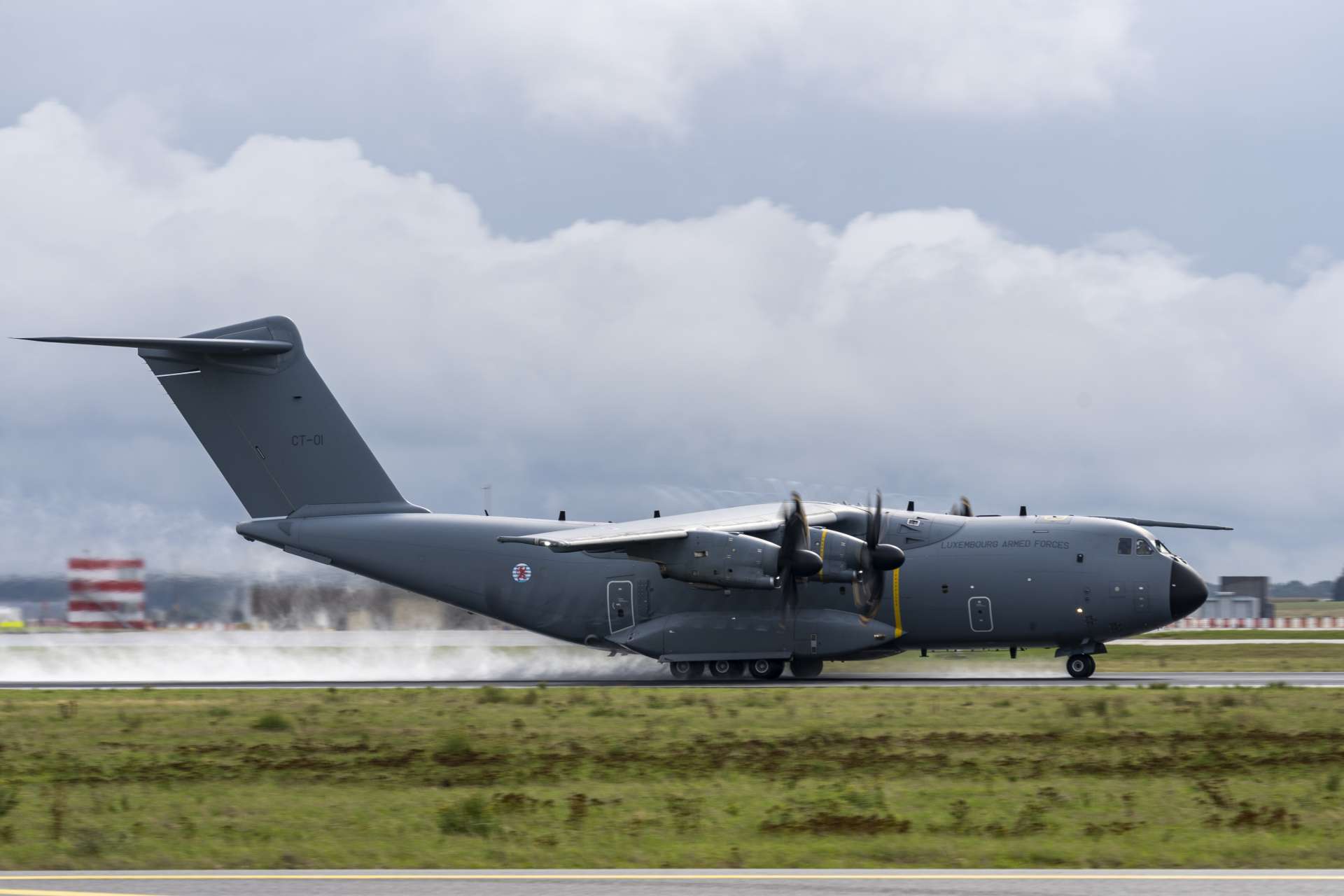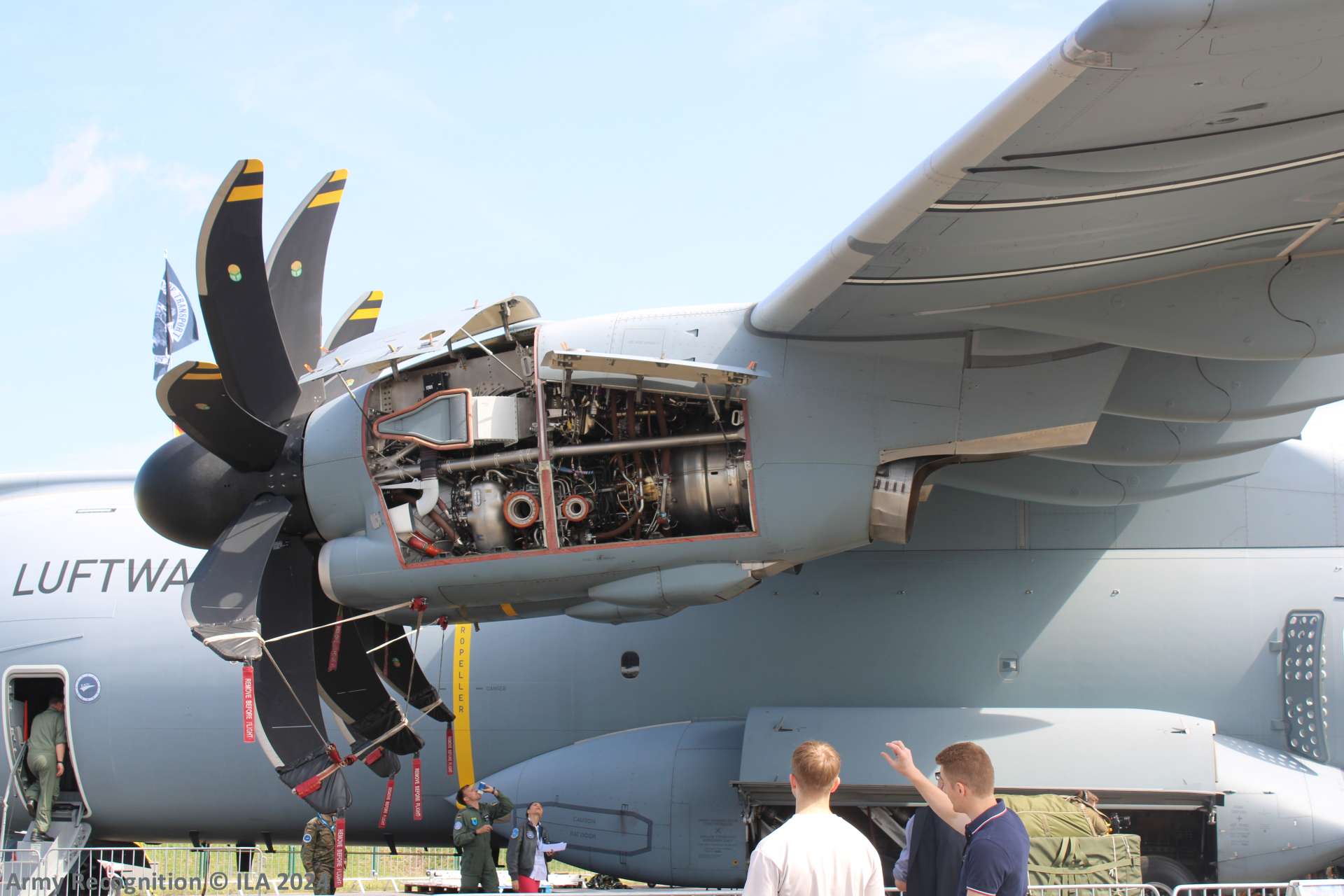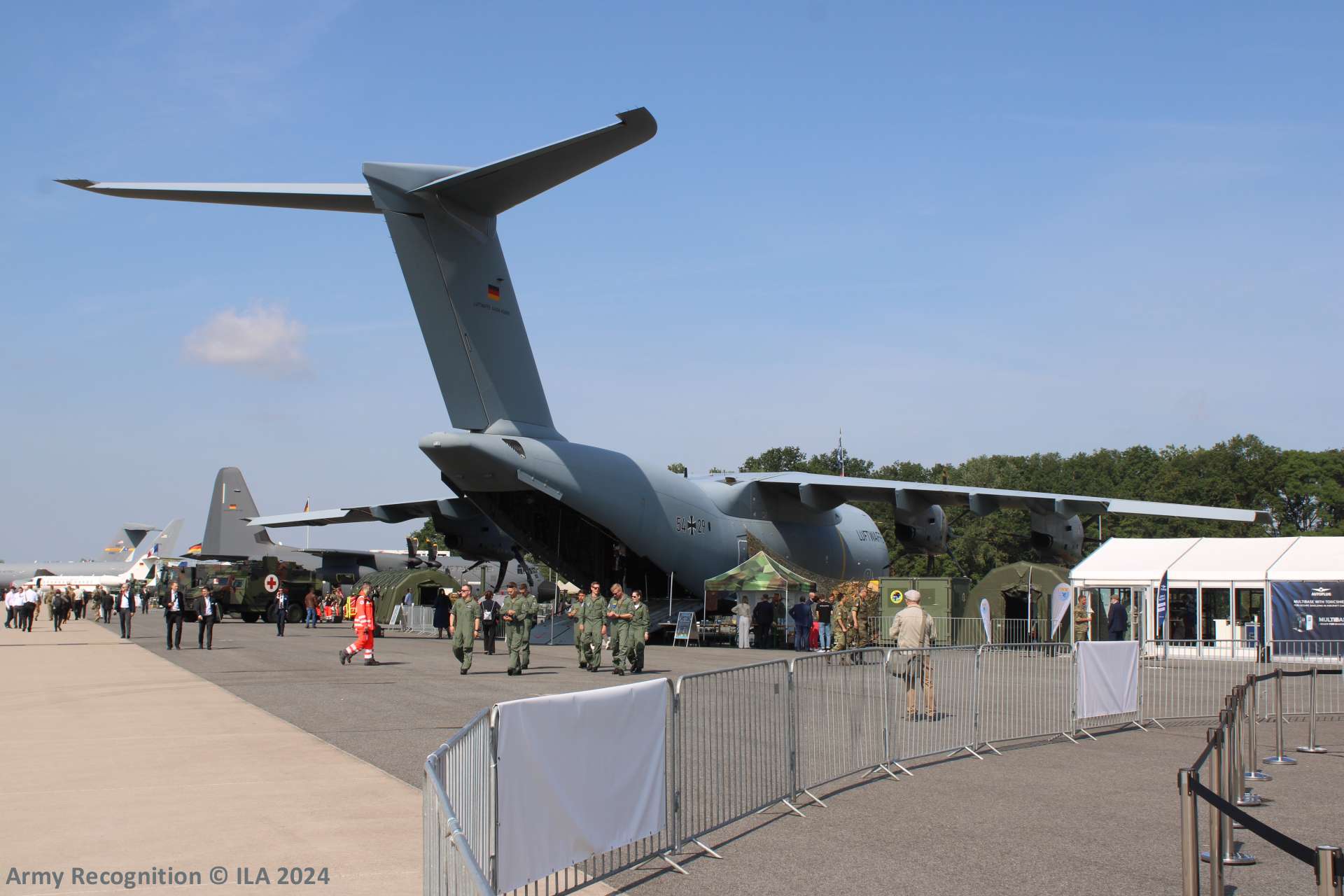Indonesia to receive its first A400M Atlas transport aircraft from Airbus in 2025

{loadposition bannertop}
{loadposition sidebarpub}
As reported by FlightGlobal on September 19, 2024, Airbus Defence & Space expects to deliver Indonesia’s first of two A400M tactical transport aircraft by late 2025. Ed Horne, senior product advisor for air mobility at Airbus, indicated that Indonesia’s versions will be equipped with underwing pods designed for refueling combat aircraft. The second aircraft is scheduled to follow in 2026, shortly after the first.Follow Army Recognition on Google News at this link
Indonesia’s A400Ms will maintain a clean cargo hold to perform transport duties while still providing air-to-air refueling capabilities using the underwing pods. (Picture source: Airbus)
Horne made these remarks on September 19 at the Bali International Air Show 2024 during a media tour of a German Air Force A400M displayed in the show’s static park. The aircraft on display is configured for air-to-air refueling and features underwing hose-and-drogue refueling pods for fighters, as well as a centerline hose installed in the turboprop’s ramp. This centerline hose can deliver 50% greater fuel flow than the wing-mounted pods and is optimized for refueling larger aircraft, such as other A400Ms. However, the centerline refueling station limits the aircraft’s cargo transport capability due to the installation of two large fuel tanks and extensive piping inside the cargo hold.
Indonesia’s A400Ms will maintain a clean cargo hold to perform transport duties while still providing air-to-air refueling capabilities using the underwing pods. Horne explained that the refueling pods for helicopters look identical to those used for fighters but contain longer hoses to remain clear of a helicopter’s rotor disc.
Air-to-air refueling has been a significant shortfall for Indonesia’s air force. According to Cirium fleets data, its only current dedicated tanker is a Lockheed Martin KC-130B that has been in service since 1961. Given the vast area that Indonesia’s air force must protect and its orders for 42 Dassault Aviation Rafale fighters, enhancing aerial refueling capabilities appears to be a priority for Jakarta. Indonesia finalized its order for the two A400Ms in late 2022. At the time of the order, the delivery timeframe was given as 2026. Additionally, Indonesia has expressed interest in the A330 Multi-Role Tanker Transport, but a firm order has yet to materialize.
Despite initial delays and budget overruns, serial production began in January 2011, and as of July 2024, a total of 127 A400Ms have been built. (Picture source: Airbus)
The Airbus A400M development began in the 1980s as a collaborative effort among European nations to replace transport aircraft such as the Transall C-160 and the Lockheed C-130 Hercules. Initially part of the Future International Military Airlifter (FIMA) group, the project faced delays due to varying requirements and international politics. After several changes and the withdrawal of partners like Lockheed, the program continued under Airbus Military. Development challenges included engine selection issues, with the Europrop TP400-D6 eventually chosen over the Pratt & Whitney Canada offering. The program experienced delays, cost overruns, and technical problems, but participating nations maintained their support, leading to the maiden flight in December 2009 and entry into service in 2013.
The Airbus A400M Atlas is a four-engine turboprop military transport aircraft designed to fill the gap between tactical airlifters like the C-130 Hercules and strategic airlifters like the C-17 Globemaster III. It features a high-wing design with a T-tail empennage and employs fly-by-wire flight controls, including side-stick controllers and a glass cockpit. The aircraft uses four Europrop TP400-D6 engines driving eight-bladed scimitar propellers in a counter-rotating configuration. Over 30% of its structure is made from composite materials, including the wings and tail. The A400M can carry up to 37 metric tons over strategic distances and operate from short, rough airstrips, allowing it to perform various military and humanitarian missions.
Production of the A400M is managed by Airbus Defence and Space, with final assembly taking place in Seville, Spain. Major components are produced across Europe and transported to Seville by Airbus Beluga aircraft. Despite initial delays and budget overruns, serial production began in January 2011. As of July 2024, a total of 127 A400Ms have been built. Key production milestones include the delivery of the first aircraft to the French Air Force in August 2013, the completion of deliveries to the United Kingdom in 2019, and the rollout of the first aircraft for Kazakhstan in April 2024. The program continues to fulfill orders for existing customers and has secured new ones, including those from Indonesia.
The A400M is powered by four Europrop TP400-D6 turboprop engines, which are among the most powerful turboprop engines in operational use in the Western world. (Picture source: Army Recognition)
In December 2023, the Belgian Air Component conducted the first A400M HIRAIN (High Mobility Artillery Rocket System Rapid Infiltration) mission, deploying an M142 HIMARS system during the Winter Shield exercise. This operation demonstrated the aircraft’s capability for rapid deployment within NATO frameworks. On June 10, 2024, the first A400M for the Republic of Kazakhstan completed its inaugural flight ahead of its scheduled delivery later in the year. The aircraft, designated MSN139, underwent extensive testing during its five-hour flight over Spain.
The Airbus A400M Atlas has a maximum payload capacity of 37,000 kg and can carry this load over a range of 3,300 km (2,100 mi). The aircraft measures 45.1 meters in length, with a wingspan of 42.4 meters and a height of 14.7 meters. It is powered by four Europrop TP400-D6 turboprop engines, each delivering 8,200 kW (11,000 hp), which are among the most powerful turboprop engines in operational use in the Western world. The A400M can reach a cruise speed of 781 km/h at an altitude of 9,000 meters and has a ferry range of 8,700 km (5,400 mi).
The cargo hold dimensions are 17.71 meters in length, 4 meters in width, and up to 4 meters in height, providing a volume of 340 cubic meters. This space allows the aircraft to transport heavy and oversized equipment, such as helicopters, armored vehicles, and other military hardware that exceed the capacity of previous-generation transport aircraft. The A400M is equipped for air-to-air refueling and medical evacuation and can accommodate up to 116 fully equipped troops or paratroopers. Its ability to operate from short, unpaved runways supports its use in various military and humanitarian missions.
The A400M Atlas, equipped for air-to-air refueling and medical evacuation, can accommodate up to 116 fully equipped troops or paratroopers thanks to a 340 m³ cargo bay. (Picture source: Army Recognition)

{loadposition bannertop}
{loadposition sidebarpub}
As reported by FlightGlobal on September 19, 2024, Airbus Defence & Space expects to deliver Indonesia’s first of two A400M tactical transport aircraft by late 2025. Ed Horne, senior product advisor for air mobility at Airbus, indicated that Indonesia’s versions will be equipped with underwing pods designed for refueling combat aircraft. The second aircraft is scheduled to follow in 2026, shortly after the first.
Follow Army Recognition on Google News at this link
Indonesia’s A400Ms will maintain a clean cargo hold to perform transport duties while still providing air-to-air refueling capabilities using the underwing pods. (Picture source: Airbus)
Horne made these remarks on September 19 at the Bali International Air Show 2024 during a media tour of a German Air Force A400M displayed in the show’s static park. The aircraft on display is configured for air-to-air refueling and features underwing hose-and-drogue refueling pods for fighters, as well as a centerline hose installed in the turboprop’s ramp. This centerline hose can deliver 50% greater fuel flow than the wing-mounted pods and is optimized for refueling larger aircraft, such as other A400Ms. However, the centerline refueling station limits the aircraft’s cargo transport capability due to the installation of two large fuel tanks and extensive piping inside the cargo hold.
Indonesia’s A400Ms will maintain a clean cargo hold to perform transport duties while still providing air-to-air refueling capabilities using the underwing pods. Horne explained that the refueling pods for helicopters look identical to those used for fighters but contain longer hoses to remain clear of a helicopter’s rotor disc.
Air-to-air refueling has been a significant shortfall for Indonesia’s air force. According to Cirium fleets data, its only current dedicated tanker is a Lockheed Martin KC-130B that has been in service since 1961. Given the vast area that Indonesia’s air force must protect and its orders for 42 Dassault Aviation Rafale fighters, enhancing aerial refueling capabilities appears to be a priority for Jakarta. Indonesia finalized its order for the two A400Ms in late 2022. At the time of the order, the delivery timeframe was given as 2026. Additionally, Indonesia has expressed interest in the A330 Multi-Role Tanker Transport, but a firm order has yet to materialize.

Despite initial delays and budget overruns, serial production began in January 2011, and as of July 2024, a total of 127 A400Ms have been built. (Picture source: Airbus)
The Airbus A400M development began in the 1980s as a collaborative effort among European nations to replace transport aircraft such as the Transall C-160 and the Lockheed C-130 Hercules. Initially part of the Future International Military Airlifter (FIMA) group, the project faced delays due to varying requirements and international politics. After several changes and the withdrawal of partners like Lockheed, the program continued under Airbus Military. Development challenges included engine selection issues, with the Europrop TP400-D6 eventually chosen over the Pratt & Whitney Canada offering. The program experienced delays, cost overruns, and technical problems, but participating nations maintained their support, leading to the maiden flight in December 2009 and entry into service in 2013.
The Airbus A400M Atlas is a four-engine turboprop military transport aircraft designed to fill the gap between tactical airlifters like the C-130 Hercules and strategic airlifters like the C-17 Globemaster III. It features a high-wing design with a T-tail empennage and employs fly-by-wire flight controls, including side-stick controllers and a glass cockpit. The aircraft uses four Europrop TP400-D6 engines driving eight-bladed scimitar propellers in a counter-rotating configuration. Over 30% of its structure is made from composite materials, including the wings and tail. The A400M can carry up to 37 metric tons over strategic distances and operate from short, rough airstrips, allowing it to perform various military and humanitarian missions.
Production of the A400M is managed by Airbus Defence and Space, with final assembly taking place in Seville, Spain. Major components are produced across Europe and transported to Seville by Airbus Beluga aircraft. Despite initial delays and budget overruns, serial production began in January 2011. As of July 2024, a total of 127 A400Ms have been built. Key production milestones include the delivery of the first aircraft to the French Air Force in August 2013, the completion of deliveries to the United Kingdom in 2019, and the rollout of the first aircraft for Kazakhstan in April 2024. The program continues to fulfill orders for existing customers and has secured new ones, including those from Indonesia.

The A400M is powered by four Europrop TP400-D6 turboprop engines, which are among the most powerful turboprop engines in operational use in the Western world. (Picture source: Army Recognition)
In December 2023, the Belgian Air Component conducted the first A400M HIRAIN (High Mobility Artillery Rocket System Rapid Infiltration) mission, deploying an M142 HIMARS system during the Winter Shield exercise. This operation demonstrated the aircraft’s capability for rapid deployment within NATO frameworks. On June 10, 2024, the first A400M for the Republic of Kazakhstan completed its inaugural flight ahead of its scheduled delivery later in the year. The aircraft, designated MSN139, underwent extensive testing during its five-hour flight over Spain.
The Airbus A400M Atlas has a maximum payload capacity of 37,000 kg and can carry this load over a range of 3,300 km (2,100 mi). The aircraft measures 45.1 meters in length, with a wingspan of 42.4 meters and a height of 14.7 meters. It is powered by four Europrop TP400-D6 turboprop engines, each delivering 8,200 kW (11,000 hp), which are among the most powerful turboprop engines in operational use in the Western world. The A400M can reach a cruise speed of 781 km/h at an altitude of 9,000 meters and has a ferry range of 8,700 km (5,400 mi).
The cargo hold dimensions are 17.71 meters in length, 4 meters in width, and up to 4 meters in height, providing a volume of 340 cubic meters. This space allows the aircraft to transport heavy and oversized equipment, such as helicopters, armored vehicles, and other military hardware that exceed the capacity of previous-generation transport aircraft. The A400M is equipped for air-to-air refueling and medical evacuation and can accommodate up to 116 fully equipped troops or paratroopers. Its ability to operate from short, unpaved runways supports its use in various military and humanitarian missions.

The A400M Atlas, equipped for air-to-air refueling and medical evacuation, can accommodate up to 116 fully equipped troops or paratroopers thanks to a 340 m³ cargo bay. (Picture source: Army Recognition)




